- The Historic Stage of Lady Gracia’s Newlywed Life
- 🚉 How to Get Here: Nagaokakyo station
- Shōryūji Castle Park
- North Gate Stone Walls: Echoes of War, Faith, and Love at Shōryūji Castle
- Exhibition Room in the Castle Tower: The Legacy of Hosokawa Tadaoki and Lady Gracia
- Photo Gallery: A Visual Journey Through Shōryūji Castle
- English translation of the Japanese-only signboards inside Shōryūji Temple.
- Nearby Attraction
- Return to Hosokawa Gracia Page
The Historic Stage of Lady Gracia’s Newlywed Life
🚉 How to Get Here: Nagaokakyo station
From Kansai International Airport (KIX)
Approx. travel time: 90 minutes
Fare: 3,210 yen
From Shin‑Osaka Station
Approx. travel time: 26 minutes
Fare: 490 yen
Shōryūji Castle Park
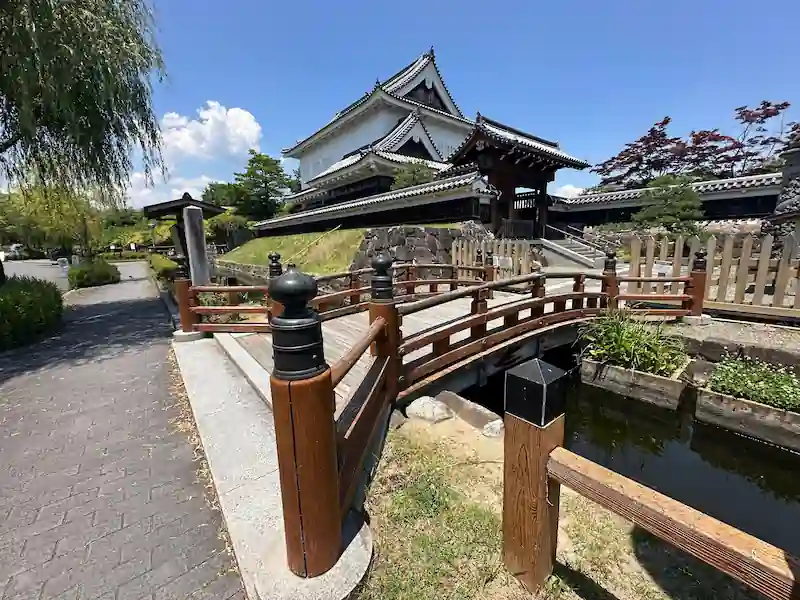
🏛 Overview
Shōryūji Castle (勝竜寺城, Shōryūji-jō) is a historic landmark that gained fame as the honeymoon residence of Hosokawa Gracia (also known as Lady Gracia), daughter of the famed general Akechi Mitsuhide and a heroine of the Sengoku period. Celebrated for her grace and resilience, Gracia later converted to Christianity and lived through one of the most turbulent periods in Japanese history. She is even said to be the inspiration for “Mariko” in NHK dramas and the Hollywood series Shōgun.
Originally built in 1339 by Hosokawa Yoriharu, the castle was rebuilt in 1571 by Hosokawa Fujitaka (Yūsai) under orders from Oda Nobunaga to serve as a modern stronghold of the time. In 1578 (Tenshō 6), the castle underwent major renovations in preparation for the marriage of Hosokawa Tadaoki and Gracia, and it was here that the newlyweds began their life together.
However, Gracia’s fate was far from peaceful. After the Honnō-ji Incident in 1582, in which her father Mitsuhide betrayed Nobunaga, Shōryūji Castle briefly served as Mitsuhide’s refuge. The area later became a key frontline position during the Battle of Yamazaki. These events intertwined the castle deeply with Gracia’s dramatic and poignant life story.
Today, the site has been transformed into Shōryūji Castle Park, featuring reconstructed turrets, gardens, and exhibitions. The tranquil setting evokes Gracia’s presence and offers a meaningful experience for visitors interested in history, culture, and the legacy of women during Japan’s Warring States era.
🗺 Address:
13-1 Shōryūji, Nagaokakyō City, Kyoto Prefecture, Japan
🚶 Access:
Nearest station: Approximately an 11-minute walk (about 0.8 km) from JR Tōkaidō Main Line Nagaokakyō Station
Note: When walking toward Shōryūji Castle, don’t forget to stop by the
The Earthworks and Dry Moat Remains of Shōryūji Castle
⏳ Suggested Visit Duration:
- For a quick visit: Around 30 minutes
- For a deeper experience: 1 to 2 hours (including museum exhibits)
📍 Highlights
🔹 Remains of the Gracia Residence:
The site of the couple’s home has been preserved and restored. Visitors can enjoy a reconstructed garden and a museum that offers insights into daily life during their time.
🔹 Main Enclosure, Replica Turrets, and Exhibition Hall:
Recreated structures showcase the architectural style of the Hosokawa clan. Inside, you’ll find replicas of wedding attire, household items from the Sengoku period, and artifacts related to Tadaoki and Gracia.
🔹 North Gate and Stone Wall Remains:
The preserved stone walls and gate structures, likely seen by Gracia herself, allow visitors to physically connect with the history of the place.
🔹 Seasonal Attractions:
In spring, cherry blossoms surround the ruins; in autumn, the gardens are wrapped in vibrant foliage. The Gracia Wedding Reenactment held beneath the sakura is especially popular and photogenic.
📌 Trivia
🔸 An Advanced Architectural Marvel:
Shōryūji Castle was ahead of its time—featuring tile roofing, stone walls, and a central tower even before the famed Azuchi Castle. Its design reflects the Hosokawa clan’s refined aesthetic sensibility.
🔸 Hidden Highlights:
The museum includes replicas of a mirror said to have belonged to Gracia and Christian-related documents, offering a unique glimpse into her faith and the role of women in history.
🔸 A Stage for Human Drama:
As the honeymoon home of Tadaoki and Gracia, and the post-Honnō-ji refuge of Akechi Mitsuhide, the castle was a backdrop for some of the Sengoku era’s most compelling personal and political narratives.
North Gate Stone Walls: Echoes of War, Faith, and Love at Shōryūji Castle
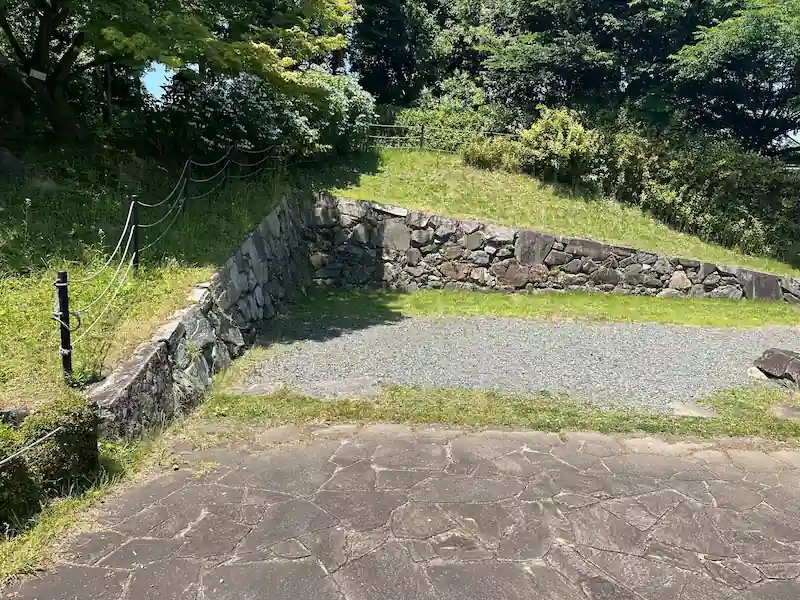
🏛 Overview
The North Gate Stone Walls of Shōryūji Castle are a rare and powerful remnant from the Sengoku period, etched with the intense conflicts and dramatic human stories of the era. Constructed in 1571 as part of a major modernization project ordered by Oda Nobunaga and executed by Hosokawa Fujitaka (also known as Yūsai), the gate featured a strategic masugata-kōguchi (square-shaped defensive entrance). A portion of the original stonework still remains today, showcasing the rustic technique known as nozurazumi—a traditional method of stacking natural, unshaped stones without mortar.
This very gate holds deep historical significance. It is said to be the last place visited by Akechi Mitsuhide in 1582 after his defeat following the Honnō-ji Incident. Earlier, in 1578, it also served as the entrance through which Hosokawa Tadaoki and Lady Gracia (then known as Akechi Tama) passed as they began their newlywed life within the castle walls.
🗺 Address:
13-1 Shōryūji, Nagaokakyō City, Kyoto Prefecture, Japan
🚶 Access:
Located within the grounds of Shōryūji Castle Park
⏳ Suggested Visit Duration:
- Quick highlight visit: Around 10 minutes
- For a full experience: 30–45 minutes (including exploration of the entire castle ruins park)
📍 Highlights
🔹 Masugata-Kōguchi (Square Gate Design):
This L-shaped defensive layout was designed to trap and expose invading enemies. The combination of sharp turns and elevated stone walls showcases the tactical genius of Sengoku-era fortification techniques.
🔹 Nozurazumi Stone Wall Technique:
The surviving lower section of the wall, built approximately 450 years ago, features rugged, natural stones arranged in an unpolished yet solid structure that reflects the raw strength of ancient craftsmanship.
🔹 Reused Stones (Tenyōseki):
Due to limited resources, sacred stones such as fragments of Buddhist statues and gorintō (five-ring pagodas) were repurposed into the wall. Look closely—you might spot the base of a Buddha figure embedded in the structure.
🔹 Seasonal Beauty:
In spring, cherry blossoms bloom gracefully above the stone walls. In autumn, the moss-covered stones contrast beautifully with fiery red and gold leaves, creating a picturesque scene that blends nature with history.
📌 Trivia
🔹 Surprising Historical Footnote:
It is believed that from this very gate, Akechi Mitsuhide fled after his defeat in the Battle of Yamazaki, embarking on his final, ill-fated journey.
🔹 Hidden Symbolism:
The reused stones embedded in the wall—many of which originated from religious monuments—offer a silent testament to the intersection of war and faith during a time of spiritual and political upheaval.
🔹 Ties to Historical Figures:
Following their wedding ceremony, Hosokawa Tadaoki and Lady Gracia are said to have entered their residence through this North Gate, making it a symbol of both the beginning of their life together and the turbulence that would soon follow.
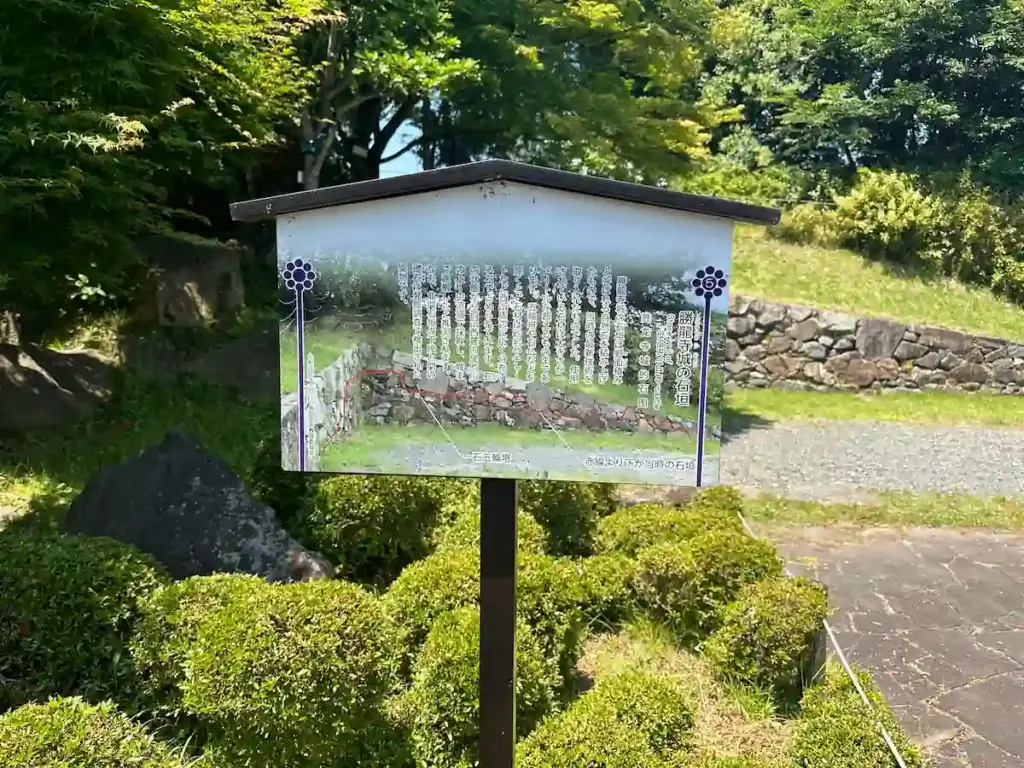
The stone walls of Shōryūji Castle were constructed using a technique known as nozurazumi, in which natural, unshaped stones are stacked without mortar. At the time, this represented cutting-edge technology in Japanese castle construction.
Some of the stones used in the walls exceed one meter in size, demonstrating the scale and effort involved. With the exception of repurposed materials such as gorintō (five-ring pagodas) and stone Buddhist images, most of the stones are sandstone and chert—rock types commonly found throughout the Nishiyama mountain range to the west of the site.
Based on the condition and composition of the stones, it is believed that they were quarried from cliffs and riverbeds along the lower to mid-stream sections of the rivers flowing from the western foothills of Nishiyama, and transported to the castle site.
Notably, the lower tier of the North Gate stone wall and the foundation stones of the gate itself were uncovered during excavation and are original, in-situ remains from the castle’s Sengoku-period construction.
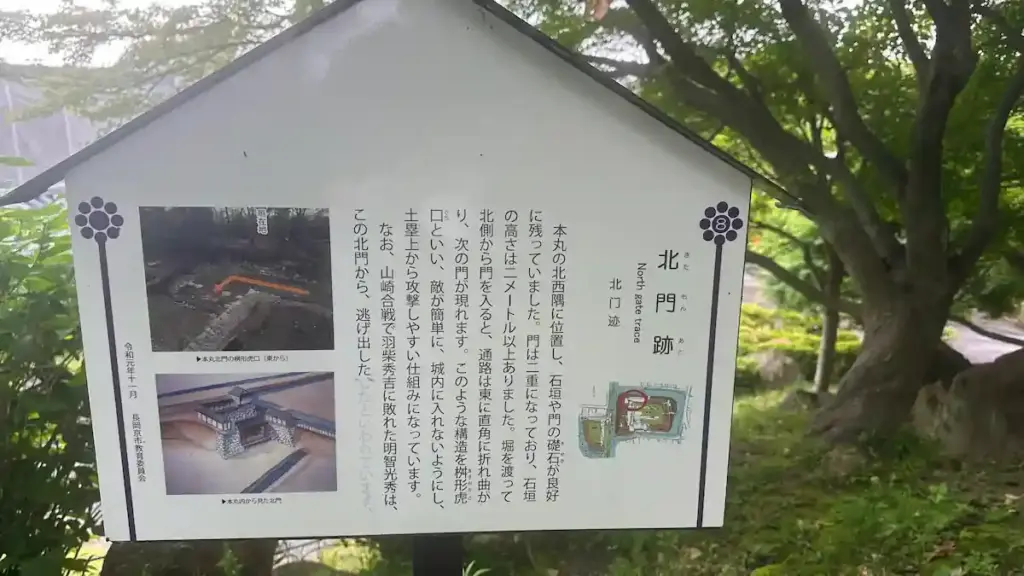
Located at the northwest corner of the main bailey, the foundation stones of the gate and surrounding stone walls remain in excellent condition. The gate was double-layered, and the stone walls stood over two meters high.
After crossing the moat and entering through the gate from the north, the path turns sharply east at a right angle, leading to a second gate. This type of layout is known as a masugata-kōguchi—a box-shaped defensive entrance designed to prevent enemies from entering easily, while also allowing defenders to launch attacks from atop the embankments.
It is said that Akechi Mitsuhide, after his defeat by Hashiba (Toyotomi) Hideyoshi in the Battle of Yamazaki, fled through this very North Gate.
Exhibition Room in the Castle Tower: The Legacy of Hosokawa Tadaoki and Lady Gracia
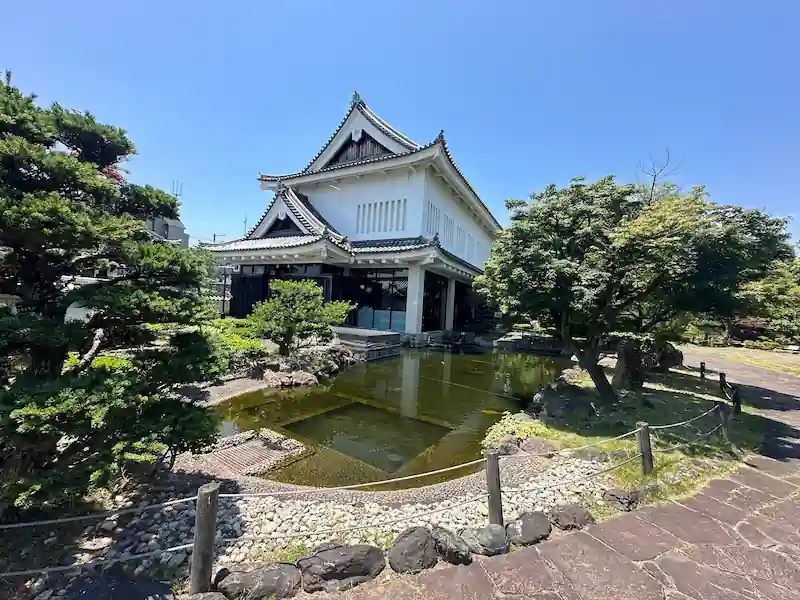
🏛 Overview
Located in the reconstructed tower of Shōryūji Castle, the Exhibition Room offers an intimate yet content-rich experience centered on the lives of Hosokawa Tadaoki and Lady Gracia, as well as the broader drama of Japan’s Sengoku-era warlords. In 1578, Akechi Tama (later known as Gracia), daughter of Akechi Mitsuhide, married Tadaoki under orders from Oda Nobunaga. Their newlywed life began right here at Shōryūji Castle.
Despite its compact size, the exhibition offers a multifaceted display covering their marriage, major battles of the time, and the cultural legacy of the Hosokawa clan. Notable features include a replica of the armor Tadaoki wore at the Battle of Sekigahara, a detailed Hosokawa family lineage chart, and documents illustrating Tadaoki’s relationship with Sen no Rikyū, Japan’s most revered tea master. These artifacts vividly bring the personalities and lives of Tadaoki and Gracia into sharp relief.
From the top of the castle tower, visitors can take in a panoramic view of the surrounding castle town. The exhibition also reflects on the fact that figures like Matsunaga Hisahide and Ashikaga Yoshiaki once sought refuge here. Though Shōryūji Castle was the Hosokawa family’s stronghold for only about two years, those brief years left an indelible mark on Japanese history. In contrast to Tadaoki’s later move to Tanabe Castle (modern-day Maizuru), this site is remembered as the couple’s first castle—their beginning.
🗺 Address:
13-1 Shōryūji, Nagaokakyō City, Kyoto Prefecture, Japan
🚶 Access:
Inside the grounds of Shōryūji Castle
⏳ Suggested Visit Duration:
- Quick visit (exhibits only): About 15 minutes
- Full experience (including video materials and interpretive panels): 30–45 minutes
📍 Highlights
🔹 Tadaoki’s Armor and the Memory of Sekigahara:
A replica of the armor Tadaoki wore during the pivotal Battle of Sekigahara is on display, along with anecdotes that reveal his volatile temperament—such as the story of him executing a roofer for delayed repairs.
🔹 Hosokawa Family Tree and Political Alliances:
Exhibits trace the lineage from Tadaoki’s father, Hosokawa Fujitaka, including how Tadaoki received the character “忠” (“loyalty”) from Nobunaga’s son Nobutada, and the story of Toyotomi Hideyoshi granting him the name “Hashiba”—highlighting the family’s deep ties to key historical figures.
🔹 Tea Culture and Sen no Rikyū:
As one of the “Seven Disciples of Rikyū,” Tadaoki held the tea ceremony in high regard. The exhibit features materials that reveal his refined sensibilities and cultural sophistication.
🔹 Gracia’s Faith and Inner Conflict:
Displays trace Gracia’s transformation—from her wedding and the birth of her children (including heir Tadataka) at Shōryūji Castle, to her eventual conversion to Christianity under the influence of Takayama Ukon. Her dramatic end—taking her own life behind a paper sliding door to preserve her faith—is presented as a moving narrative of devotion and destiny.
🔹 International Perspective:
Gracia’s martyrdom was recorded by European missionaries, earning her recognition abroad as the “Oriental Saint.” Her story continues to inspire faith-based and historical interest beyond Japan.
🔹 Fujitaka’s Cultural Defiance:
After the Honnō-ji Incident, Fujitaka refused to join Mitsuhide’s rebellion—not out of fear, but due to his commitment to completing a sacred literary rite known as Kokin Denju. This cultural conviction is believed to have spared his life.
📌 Trivia
🔸 Surprising Historical Background:
Despite hosting the Hosokawa family for only two years, Shōryūji Castle also provided refuge to powerful warlords like Ashikaga Yoshiaki and Matsunaga Hisahide, marking it as a key site in the shifting tides of Sengoku-era power.
🔸 Little-Known Insights:
The exhibition includes rare records of Gracia inviting her father, Mitsuhide, to Miyazu Castle—a curious glimpse into their complex and perhaps strained relationship.
🔸 Connections to Legendary Figures:
Through the lives of Tadaoki and Gracia, visitors can trace direct links to giants like Nobunaga, Hideyoshi, Ieyasu, and Sen no Rikyū—making the exhibition a valuable gateway into the human side of Japan’s greatest military and cultural icons.
Photo Gallery: A Visual Journey Through Shōryūji Castle
English translation of the Japanese-only signboards inside Shōryūji Temple.
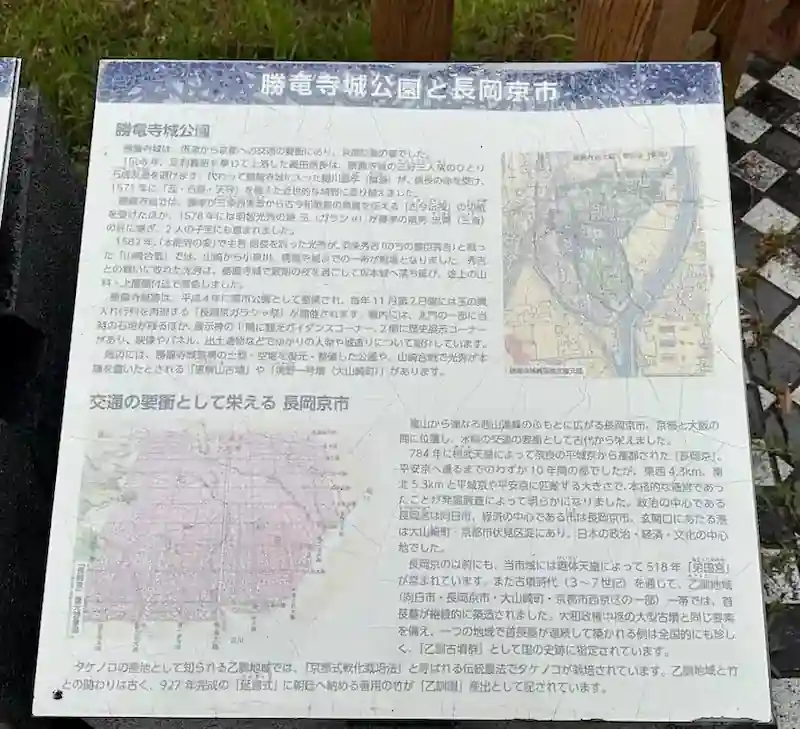
🏯 Shōryūji Castle Park
Shōryūji Castle was once a strategic military post located on a key transportation route between Settsu (modern-day Osaka) and Kyoto, and it played an important role in the defense of the ancient capital.
In 1568, as Oda Nobunaga entered Kyoto supporting Ashikaga Yoshiaki’s rise to shogunate power, he ousted Ishinari Tomomichi, one of the Miyoshi Three—who controlled Shōryūji Castle at the time. Nobunaga then entrusted Hosokawa Fujitaka (Yūsai) with the fortress. In 1571, under Nobunaga’s order, Fujitaka reconstructed Shōryūji Castle into a modern stronghold, complete with tiled roofs, stone walls, and a central keep—hallmarks of early modern Japanese castles.
During his time at the castle, Fujitaka received the prestigious “Kokin Denju” transmission of Kokin Wakashū poetry secrets from Sanjōnishi Sanetaka. In 1578, his son Hosokawa Tadaoki (also known as Sansai) married Tama, the daughter of Akechi Mitsuhide. She would later become known as Gracia after converting to Christianity. The couple began their married life at Shōryūji Castle and had two children during their time there.
In 1582, following the Honnō-ji Incident, Mitsuhide betrayed and assassinated Nobunaga. Shortly afterward, he confronted Toyotomi Hideyoshi (then known as Hashiba Hideyoshi) in the Battle of Yamazaki. The battleground stretched from Yamazaki to the Koizumigawa River and included the area around Shōryūji Castle. Defeated, Mitsuhide is said to have spent his final night at the castle before fleeing toward Sakamoto Castle. He was ultimately killed near Yamashina or Kamidaigo.
In 1992 (Heisei 4), the ruins of Shōryūji Castle were transformed into a public park. Every year on the second Sunday of November, the Nagaokakyō Gracia Festival is held, reenacting Lady Gracia’s bridal procession. Within the park, remnants of the original stone walls of the North Gate can still be seen. The visitor center includes:
- A tourist information area on the 1st floor
- A historical exhibition room on the 2nd floor — Here, visitors can explore the lives of Gracia and Tadaoki through videos, interpretive panels, and excavated artifacts.
Surrounding the castle park are several historically significant sites:
- A reconstructed earthen embankment and dry moat, part of the castle’s original outer defenses
- The Egeyama Kofun (burial mound), believed to have been Mitsuhide’s field headquarters during the Battle of Yamazaki
- Sakaino Kofun No. 1 in nearby Ōyamazaki
🚉 Nagaokakyō: A City Shaped by Strategic Location
Nagaokakyō is nestled at the foot of the Nishiyama mountain range, stretching from the Arashiyama area. Situated between Kyoto and Osaka, the city has flourished since ancient times as a key intersection of waterway and land transportation routes.
In 784, Emperor Kanmu relocated the capital from Nara’s Heijō-kyō to establish the new Nagaoka-kyō. Though it served as the capital for only about 10 years before the move to Heian-kyō (Kyoto), Nagaoka-kyō was impressively large, spanning 4.3 km east-west and 5.3 km north-south—comparable in size and planning to both Heijō-kyō and Heian-kyō. Archaeological excavations have revealed a carefully planned city grid and monumental government complexes.
- The political center (Chōdō-in) was located in modern-day Muko City
- The economic hub (market area) was within present-day Nagaokakyō
- The main port faced the Yodo River near Ōyamazaki and Yodo in Fushimi Ward, Kyoto
These districts formed the backbone of ancient Japan’s political, economic, and cultural infrastructure.
Even before Nagaoka-kyō’s brief time as the capital, the area was historically significant. In 518, Emperor Keitai established Otokuni-no-miya, an imperial residence. Throughout the Kofun period (3rd–7th century), the broader Otokuni region—including Muko, Nagaokakyō, Ōyamazaki, and parts of Nishikyō Ward—saw the continuous construction of elite burial mounds. These tombs share features with those of Japan’s ruling Yamato dynasty, and such a concentrated cluster is considered unique nationwide. The area is now recognized as the Otokuni Kofun Group, a nationally designated Historic Site.
The Otokuni region is also well known as a bamboo shoot production center, where the traditional Kyoto-style tender cultivation method is still practiced. The area’s connection to bamboo is ancient: the 927 CE Engishiki (a Heian-period book of laws and customs) records bamboo from the “Otokuni Garden” as offerings to the imperial court for use in chopsticks.

In 1571 (Genki 2), under orders from Oda Nobunaga, Hosokawa Fujitaka undertook a major renovation of the pre-existing Shōryūji Castle, transforming it into a large-scale military stronghold for the defense of Kyoto.
Archaeological excavations conducted in 1988 (Shōwa 63) revealed that the castle incorporated cutting-edge construction techniques of the time, including roof tiles, foundation stone structures (palatial buildings), and stone walls.
The main bailey (honmaru) was a rectangular area measuring approximately 120 meters east-west and 80 meters north-south, enclosed by earthen embankments 4 to 5 meters high. A moat surrounded the outer perimeter, measuring 10 to 15 meters wide and around 3 meters deep. The inner side of the moat, adjacent to the bailey, was lined with a stone retaining wall. Beneath this wall, wooden foundations were laid to prevent subsidence—an advanced engineering solution for its time.
Interestingly, in addition to natural stones, the stone walls also incorporated reused religious artifacts, such as Buddhist statues and gorintō (five-ring pagodas)—a rare example of repurposed sacred materials in castle construction.
Fragments of nokimarugawara (round eave tiles) and nokihiragawara (flat eave tiles) found at the site closely resemble those excavated from Sakamoto Castle, built by Akechi Mitsuhide in modern-day Ōtsu, Shiga Prefecture, and Komaru Castle, associated with Sassa Narimasa in present-day Echizen, Fukui Prefecture. These similarities strongly suggest that the same molds were used to produce tiles for castles built under Nobunaga’s vassals. It is believed that skilled roof tile artisans were dispatched across various castle sites under Oda clan control, enabling standardized and efficient castle construction.
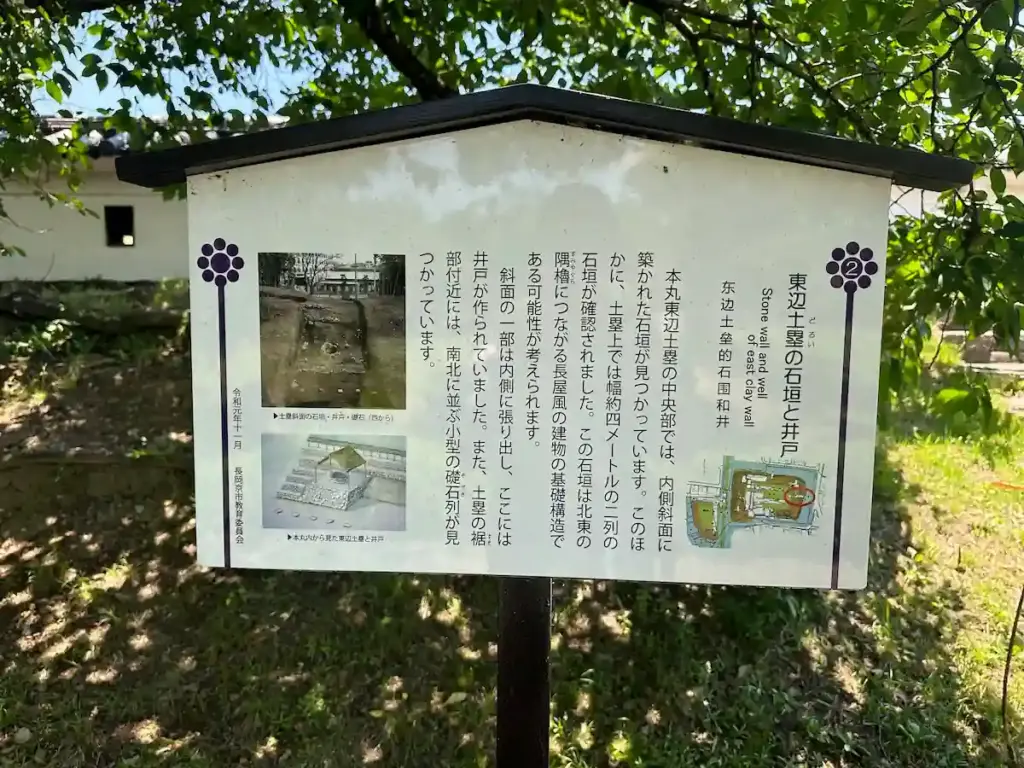
At the central section of the eastern rampart of the main bailey, archaeologists uncovered a stone wall built into the inner slope. In addition, a double row of stone foundations, approximately four meters wide, was found along the top of the rampart. These may have formed the structural base of a long, barrack-style building, possibly connected to the northeastern corner turret (yagura).
Part of the slope juts inward, and within this recessed area, a well was constructed—an essential feature for sustaining life during sieges. Near the base of the rampart, a line of small foundation stones arranged north to south was also discovered, suggesting the presence of a series of smaller buildings or support structures in this section of the fortress.
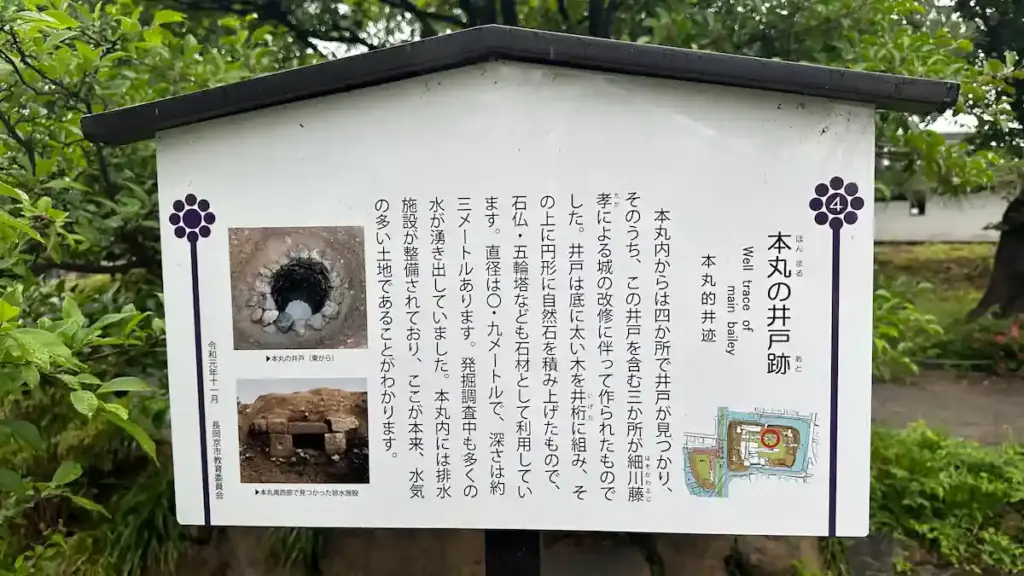
Archaeological excavations within the main bailey (honmaru) revealed a total of four wells, three of which—including this one—are believed to have been constructed during the large-scale renovations carried out by Hosokawa Fujitaka.
The well was built using a wooden crossbeam foundation (constructed in a 井 shape) at the base, upon which natural stones were carefully stacked in a circular formation. Notably, reused religious artifacts, such as stone Buddha images and gorintō (five-ring pagodas), were also incorporated as building materials.
The well measures approximately 0.9 meters in diameter and reaches a depth of about 3 meters. During the excavation, a significant volume of water was found to be naturally springing up, indicating the area’s high groundwater levels.
In fact, drainage systems discovered within the bailey suggest that this land was originally water-rich terrain, requiring careful engineering to ensure the castle’s long-term habitability.
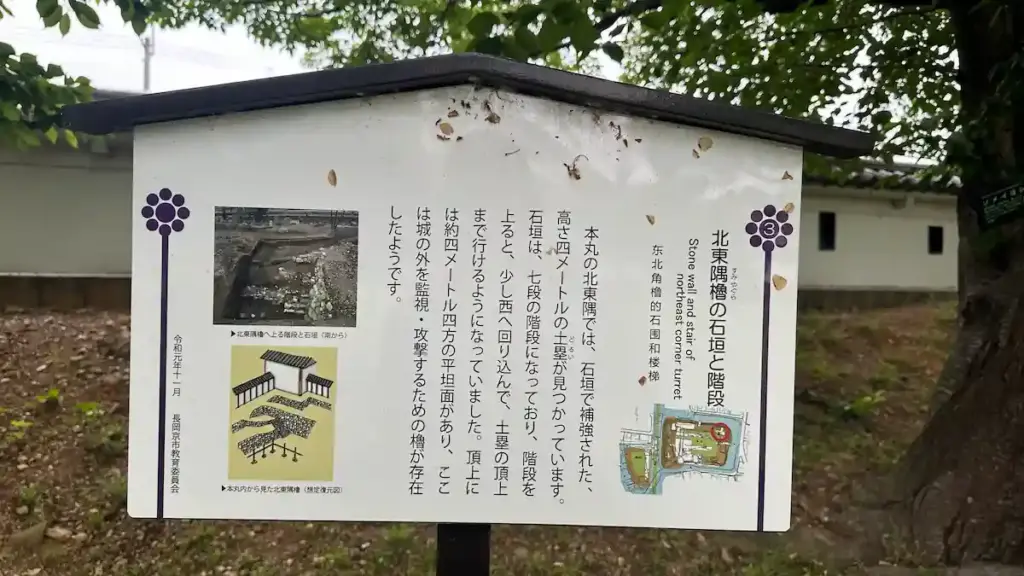
At the northeast corner of the main bailey, excavations revealed an earthen embankment approximately 4 meters high, reinforced with stone walls.
The stonework forms a seven-step staircase, which leads up the embankment and curves slightly to the west, allowing access to the top.
At the summit lies a flat area roughly 4 meters square, which is believed to have once supported a turret used for monitoring and defending the castle perimeter.
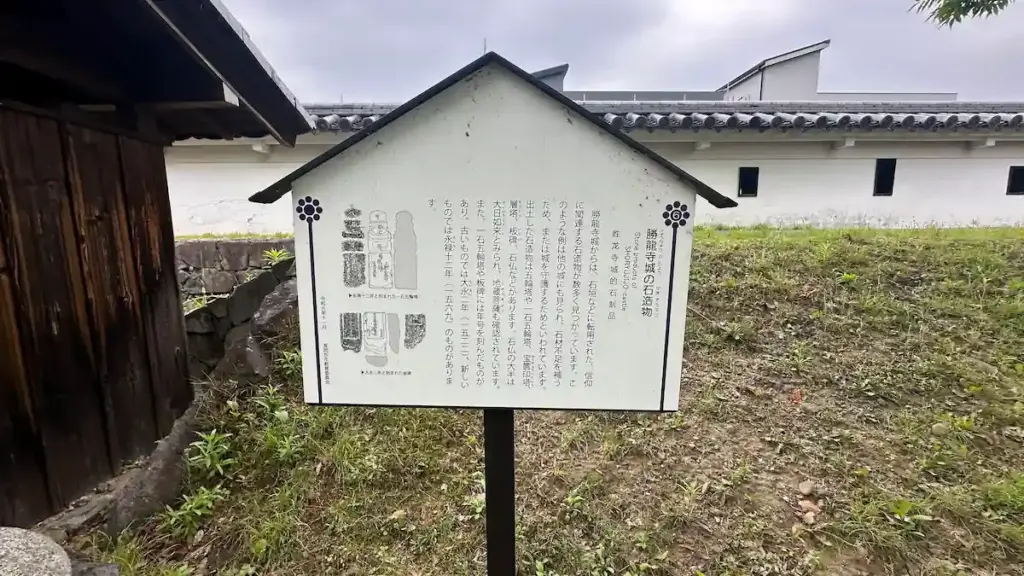
Excavations at Shōryūji Castle have uncovered a large number of religious stone artifacts that were repurposed for use in stone walls and other structural elements. Similar examples have been found at other castles as well, believed to be a response to shortages of building materials, or as a means of invoking spiritual protection for the fortress.
Artifacts discovered at the site include gorintō (five-ring pagodas), hōkyōintō (precious pagoda stupas), tiered stone pagodas, itabi (stone steles), and stone Buddha images. Most of the stone Buddhas are thought to represent Dainichi Nyorai (Mahāvairocana), and some Jizō Bosatsu (Kṣitigarbha) figures have also been identified.
Several of the gorintō and itabi bear inscribed dates, ranging from as early as Daiei 3 (1523) to as late as Eiroku 12 (1569), offering valuable insight into the artifacts’ origins and historical context.
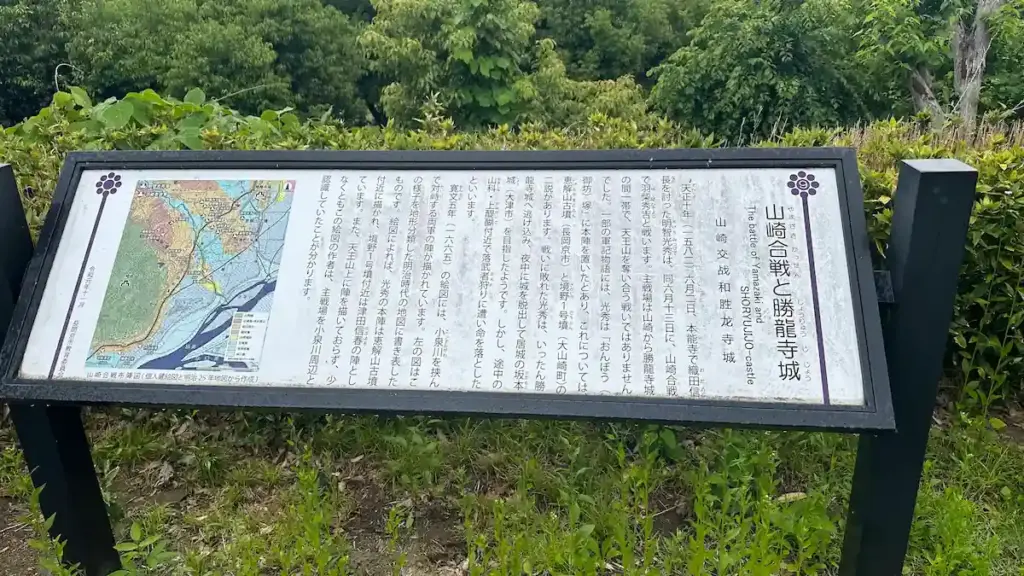
On June 2, 1582 (Tenshō 10), Akechi Mitsuhide assassinated Oda Nobunaga at Honnō-ji Temple. Just eleven days later, on June 13, he clashed with Hashiba Hideyoshi (later known as Toyotomi Hideyoshi) in the Battle of Yamazaki.
The primary battlefield stretched across the area between Yamazaki and Shōryūji Castle, and contrary to popular belief, the conflict was not centered around a struggle to control Mount Tennōzan itself.
According to certain historical war chronicles, Mitsuhide is said to have established his main camp at Onbō-no-tsuka (御坊ノ塚), placing his base near Egeyama Kofun in present-day Nagaokakyō and Sakaino No. 1 Kofun in Ōyamazaki. He is believed to have temporarily retreated into Shōryūji Castle, then fled under the cover of night, aiming to return to his own stronghold at Sakamoto Castle (in modern-day Ōtsu City). However, one theory holds that he was intercepted and killed near Yamashina or Kamidaigo, possibly during a sweep to eliminate retreating soldiers.
A map from Kanbun 5 (1665) depicts the opposing armies facing off across the Koizumi River. The map on the left represents a topographical reinterpretation of that scene using Meiji-era geographical data. According to this map, Mitsuhide’s main camp was at Egeyama Kofun, while the area around Sakaino No. 1 Kofun is labeled as the camp of Tsuda Nobuharu, one of Hideyoshi’s commanders. Notably, there is no indication of troop deployment atop Mount Tennōzan, suggesting that the map’s creator regarded the vicinity of the Koizumi River as the primary battleground.
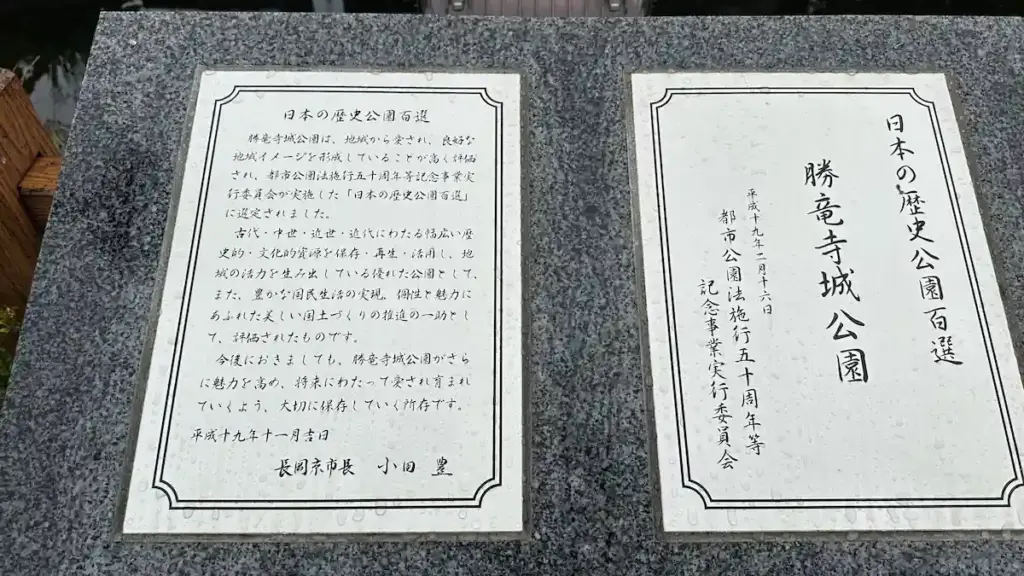
Shōryūji Castle Park has been highly praised for its strong local appeal and its role in shaping a positive regional identity. As a result, it was selected as one of the “Top 100 Historic Parks in Japan”, a designation organized by the Executive Committee for the 50th Anniversary of the Urban Parks Act.
The park was recognized for its exceptional preservation, revitalization, and use of historical and cultural assets spanning from ancient to medieval, early modern, and modern times. It stands as a model of how local heritage can be leveraged to foster community vitality, while also contributing to the realization of a rich and fulfilling national life and the creation of a beautiful, unique, and attractive landscape.
Looking ahead, we remain committed to preserving Shōryūji Castle Park with great care so that it may continue to grow in cultural significance and be cherished by future generations.
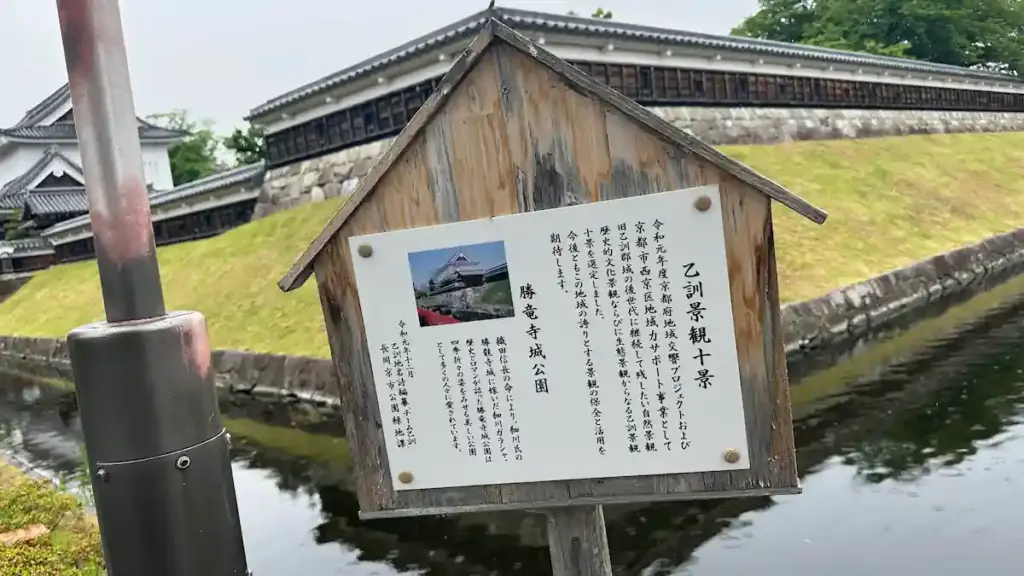
As part of the 2020 Kyoto Prefectural Regional Symphony Project and the Nishikyō Ward Community Support Initiative, ten landscapes within the former Otokuni District have been selected as the “Otokuni Scenic Ten Views.”
These sites represent natural environments, historic cultural landscapes, and ecological scenery that should be preserved and passed down to future generations.
We hope these cherished landscapes will continue to be preserved and utilized as sources of local pride and identity.
Shōryūji Castle Park
Lady Gracia (Hosokawa Tama), the daughter of Akechi Mitsuhide, married into the Hosokawa family and took up residence in Shōryūji Castle by order of Oda Nobunaga.
Today, Shōryūji Castle Park—rich in history and romance—is a beautiful, tranquil space that showcases the changing beauty of all four seasons and continues to be loved by many.
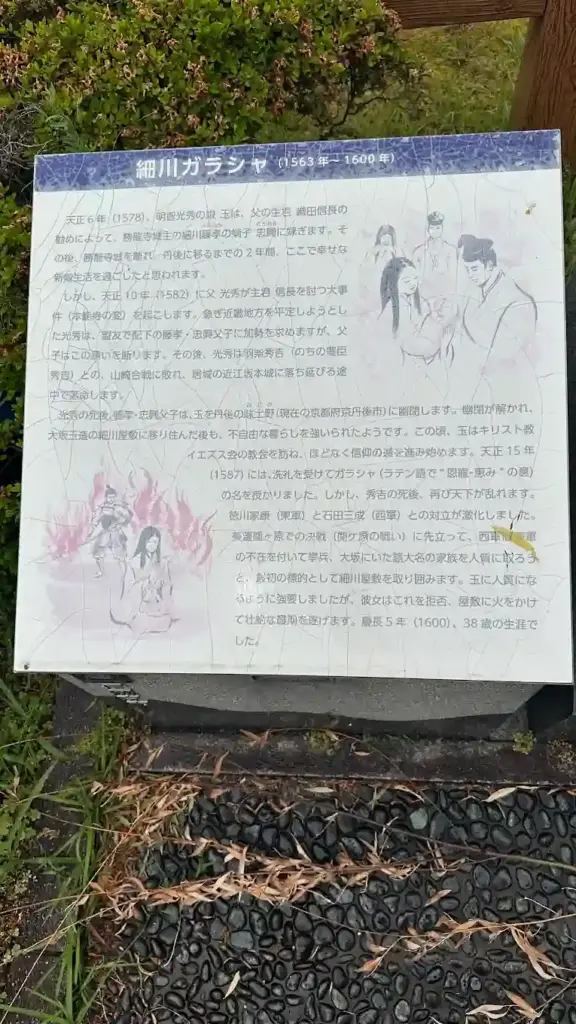
In 1578 (Tenshō 6), Tama, the daughter of Akechi Mitsuhide, was married to Hosokawa Tadaoki, heir of Hosokawa Fujitaka, the lord of Shōryūji Castle. The marriage was arranged at the recommendation of her father’s lord, Oda Nobunaga.
After the wedding, Tama lived at Shōryūji Castle for about two years, until the couple moved to Tango Province. It is believed that these were the happiest years of her life, spent in newlywed bliss.
However, in 1582 (Tenshō 10), her father Mitsuhide staged a shocking coup by assassinating Nobunaga in what became known as the Honnō-ji Incident. Attempting to quickly gain control over the Kansai region, Mitsuhide sought the support of his former allies, Fujitaka and Tadaoki. However, the father and son rejected his offer.
Soon after, Mitsuhide was defeated by Hashiba (Toyotomi) Hideyoshi at the Battle of Yamazaki and was killed while fleeing toward his castle in Sakamoto, Ōmi Province.
Following Mitsuhide’s death, Fujitaka and Tadaoki confined Tama to Midono in Tango Province (present-day Kyōtango City, Kyoto Prefecture). Though later released and relocated to the Hosokawa residence in Tamatsukuri, Osaka, she continued to live under heavy restrictions.
It was during this time that Tama encountered Jesuit missionaries and began exploring the teachings of Christianity. In 1587 (Tenshō 15), she was baptized and received the Christian name Gracia—from the Latin word for “grace.”
After Hideyoshi’s death, Japan once again plunged into turmoil. As tensions between Tokugawa Ieyasu’s Eastern Army and Ishida Mitsunari’s Western Army escalated, the Western forces sought to seize the families of daimyo loyal to the Eastern Army as hostages. The Hosokawa residence in Osaka was one of their first targets.
Gracia was ordered to surrender as a hostage, but she refused. Instead, she ordered her retainers to set fire to the residence, choosing to end her own life rather than be captured. She died in 1600 (Keichō 5) at the age of 38, just before the decisive Battle of Sekigahara.
Nearby Attraction
The Earthworks and Dry Moat Remains of Shōryūji Castle
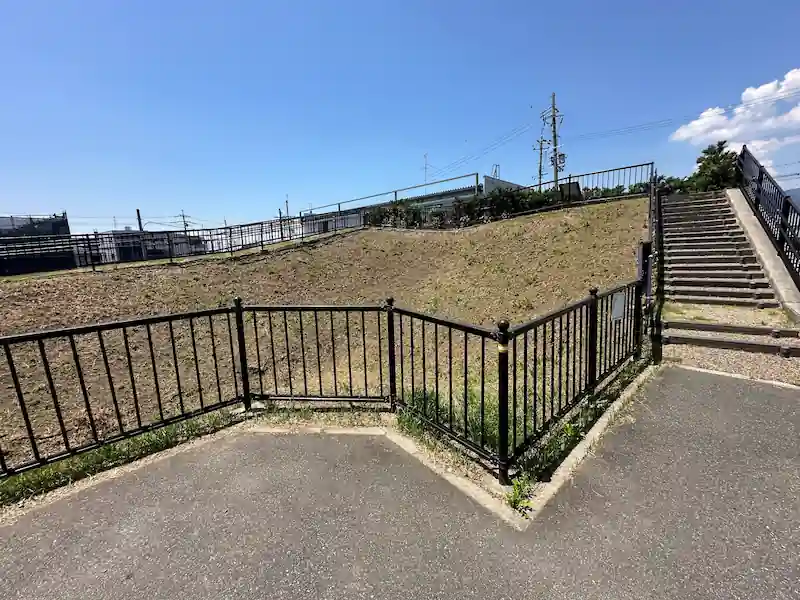
🏛 Overview
Located just a short walk from Shōryūji Castle, the earthworks and dry moat remains are part of a large-scale defensive system built in 1571 by Hosokawa Fujitaka (Yūsai). These structures formed a sōgamae—a comprehensive line of defense encircling not only the castle but the entire castle town. Today, visitors can still witness the towering 6-meter-high embankments and deep moats that reflect the original Sengoku-period fortification techniques. Such large-scale remains are extremely rare in the Kansai region, making this a highly valuable and tangible historical site for understanding wartime defense strategies of the era.
🗺 Address:
2-16-3 Higashikōtari, Nagaokakyō City, Kyoto Prefecture (next to Kōtari Shrine)
🚶 Access:
Nearest station: About 8 minutes on foot (approx. 600 meters) from JR Tōkaidō Main Line Nagaokakyō Station
⏳ Suggested Visit Duration:
- For a brief visit: Around 15 minutes
- For a more in-depth exploration: 30–45 minutes (including reading explanatory signs and studying the layout)
📍 Highlights
🔹 6-Meter-High Earthen Embankment:
From the base of the moat to the crest, the embankment stands at around 6 meters tall, with a width of 7.5 meters and a crest width of 3.4 meters. Informational boards onsite illustrate this scale with diagrams, and the visible layered cross-section reveals the precise techniques used in its construction.
🔹 Deep Dry Moat and Earthen Bridge:
The moat structure includes a preserved yokoya-kakari (angled defense line) and a narrow earthen bridge that spans the trench. These features allowed defenders to control enemy access and create natural choke points for ambush or sniping.
🔹 Rare Example of Sōgamae Fortifications:
Unlike typical castle defenses that protect only the main keep, this sōgamae surrounded the entire castle town. This level of strategic foresight is rare even on a national scale, offering a first-hand look at comprehensive military defense planning in feudal Japan.
🔹 Interpretive Panels and Layout Diagrams:
Located on the grounds of nearby Kōtari Shrine, these educational panels explain the historical and structural significance of the earthworks and moats in easy-to-understand terms with detailed illustrations.
📌 Trivia
🔸 Built Using an Ancient Burial Mound:
Parts of the embankment were constructed using earth from a kofun (ancient burial mound), illustrating the site’s deep, layered history and how older cultural landscapes were repurposed for wartime needs.
🔸 Visible Soil Layering:
You can clearly observe alternating bands of black and yellow soil, revealing the step-by-step construction methods used centuries ago—a rarity in Japanese castle remains.
🔸 Educational and Cultural Importance:
Designated as a City Cultural Property in 2021 (Reiwa 3), the site has undergone extensive archaeological investigation and restoration since the Showa era. It is now considered an academically significant location for the study of Sengoku-period military architecture.
Shōryūji Temple: A Sacred Space of Rain, Resilience, and Lady Gracia’s Legacy
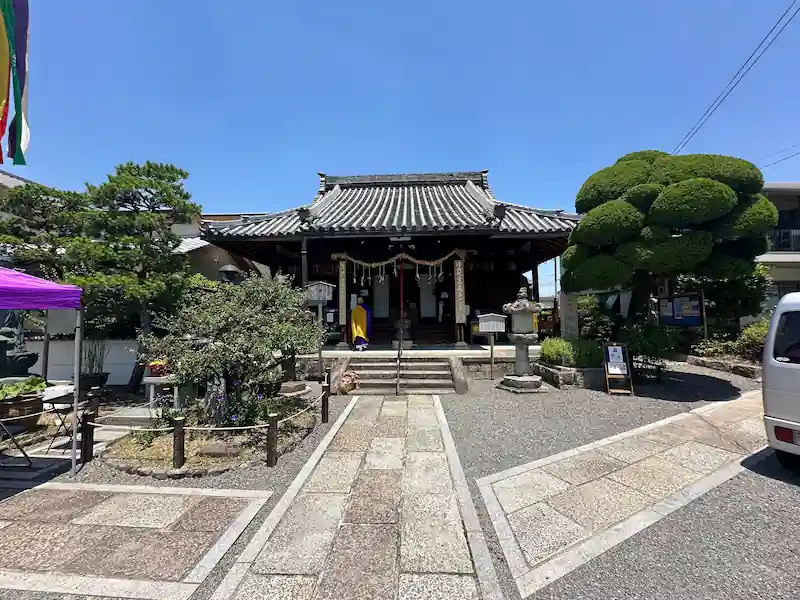
🏛 Overview
Shōryūji Temple is a revered Buddhist temple of the Shingon Sanbō-shū sect, recognized as the 14th site on the Rakusai Kannon Pilgrimage in Kyoto’s western region. Founded in 806 CE (Daidō 1), it is traditionally attributed to the great Buddhist monk Kūkai (Kōbō-Daishi). Originally named Egesan Seiryūji, the temple was modeled after Eryū-ji in Aki Province, reflecting Kūkai’s admiration for Tang Chinese temple architecture upon his return from China.
During the Heian period, it flourished as a major monastic complex with 99 sub-temples. In 962 CE (Ōwa 2), amid a severe drought, the monk Sengan prayed to the Eleven-Headed Kannon, miraculously bringing rain. This event gave rise to the name “Shōryūji”—meaning “the temple that defeated the dragon (of drought).”
The temple’s principal deity is an Eleven-Headed Kannon statue from the Kamakura period, designated as an Important Cultural Property of Japan. Alongside it are guardian statues of Jikokuten and Tamonten, also from the Kamakura era, designated cultural properties by Nagaokakyō City. The awe-inspiring main hall enshrines these figures in a setting that invites deep spiritual reflection.
Another treasure, the ancient temple bell (bonshō) cast in 1319 (Gen’ō 1), is currently preserved at Shinnyo-ji Temple in Nose, Osaka. Though the original bell was destroyed in wartime during the Edo period, it was recast in 1336 (Engen 1), and its historical and cultural value remains immense.
Shōryūji Temple also shares a unique bond with Shōryūji Castle, located nearby. It is said that the temple served as a place of prayer for Hosokawa Tadaoki and Lady Gracia (Akechi Tama) during their early married life. Today, the temple plays a key role in the annual Nagaokakyō Gracia Festival, honoring Lady Gracia’s legacy and spiritual presence.
In addition to its rich tradition, the temple engages actively with the local community through modern initiatives. These include intricately designed paper-cutting goshuin (temple seals), temple yoga sessions, herbal tea experiences, and the monthly Hotei Market (Hotei-ichi)—transforming the temple into a welcoming space that harmonizes heritage with innovation.
🗺 Address:
19-25 Shōryūji, Nagaokakyō City, Kyoto Prefecture, Japan
🚶 Access:
- About a 10–12 minute walk from JR Tōkaidō Main Line Nagaokakyō Station (East Exit)
- About 20–30 minutes on foot from Nagaoka-Tenjin Station or Nishiyama-Tennōzan Station on the Hankyu Kyoto Line
⏳ Suggested Visit Duration:
- Quick visit (main hall and garden): ~20 minutes
- Full experience (including goshuin, programs, and grounds): ~1 hour
📍 Highlights
🔹 Main Hall & Eleven-Headed Kannon Statue:
This Kamakura-period statue, a designated Important Cultural Property, is displayed to the public during special events such as the Kannon Grand Festival (August 18) and the Gracia Festival (2nd Sunday of November).
🔹 “Victory Over the Dragon” Plaque and Sacred Rope:
The main hall proudly displays a calligraphy plaque reading “Ryū ni Katsu” (To Defeat the Dragon). Each year, a majestic upward-facing dragon-shaped shimenawa (sacred rope) is replaced during major temple festivals, symbolizing strength and renewal.
🔹 Artistic Goshuin & Temple Yoga:
Visitors can enjoy seasonal paper-cutting goshuin—delicately crafted temple stamps—as well as participate in yoga sessions or combine a kirie workshop with herbal tea for a tranquil spiritual retreat.
🔹 Hotei Market & Wellness Offerings:
On the second Sunday of every month (except January and August), the temple hosts a lively Hotei-ichi market. Dedicated to community and well-being, this event features local vendors, workshops, and Buddhist-themed goods.
🔹 Gracia Festival Connection:
A key venue during Nagaokakyō’s Gracia Festival, the temple forms part of the parade route and serves as a historical anchor where visitors reflect on the spiritual life of Lady Gracia and her connection to this sacred place.
📌 Trivia
🔸 Origin of the Temple’s Name:
After the monk Sengan’s prayers ended a catastrophic drought, the temple was renamed “Shōryūji”—meaning “Temple that Defeated the Dragon”—in reference to the rain-bringing dragon deity.
🔸 Rich Cultural Holdings:
In addition to the Eleven-Headed Kannon, the grounds house multiple designated cultural properties, including wooden standing bodhisattva figures and guardian deities (shinsō), enriching its spiritual and historical depth.
🔸 Ties to Lady Gracia:
Shōryūji Temple is believed to have served as a place of worship and solace for Lady Gracia and Hosokawa Tadaoki during their time at nearby Shōryūji Castle. During the Gracia Festival, the temple becomes a stage where visitors can connect with her spiritual and emotional legacy.
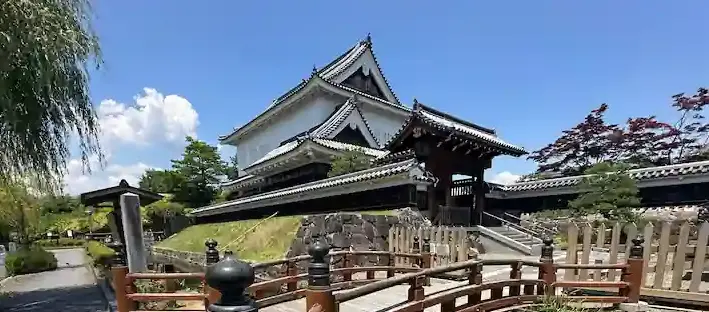

comment